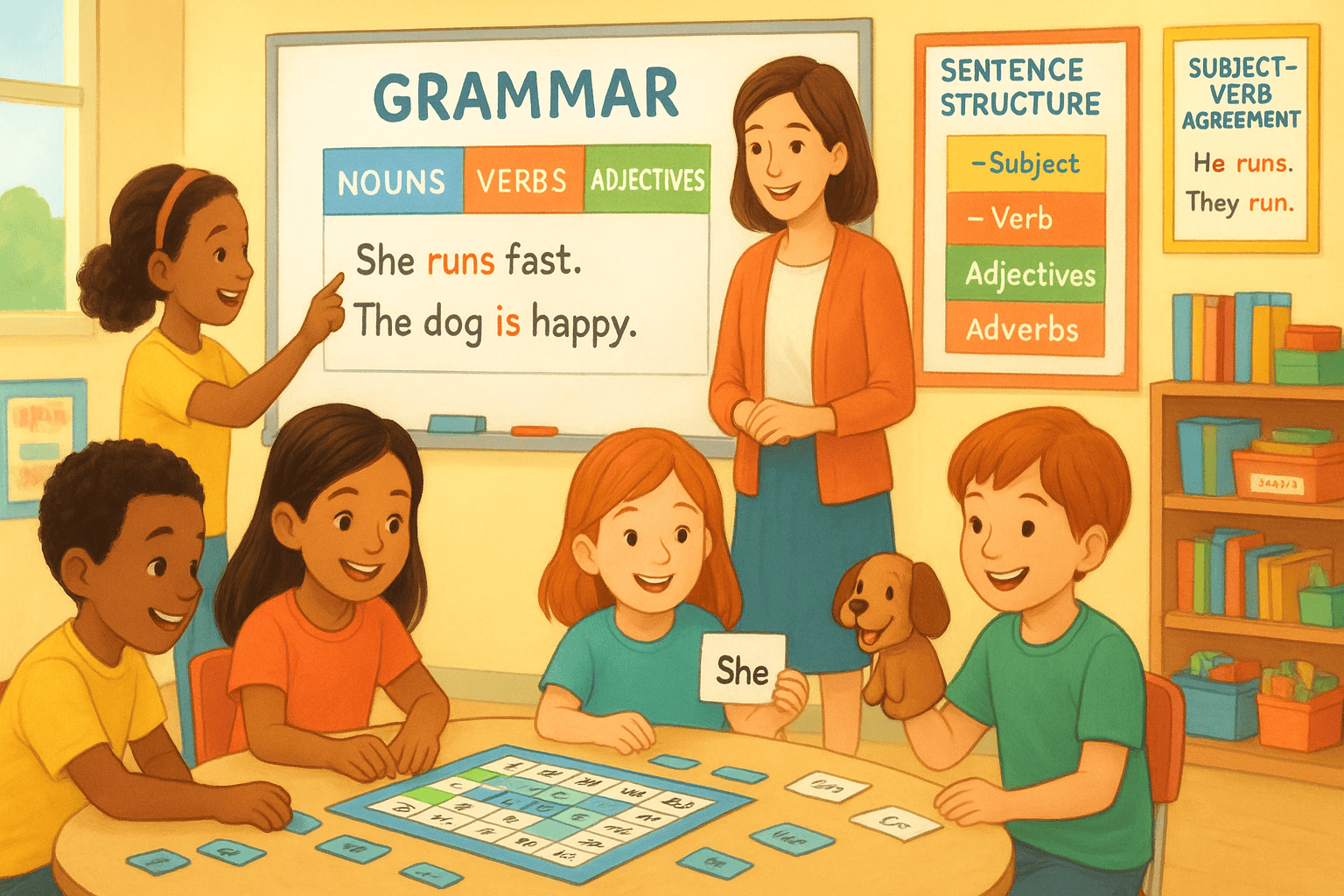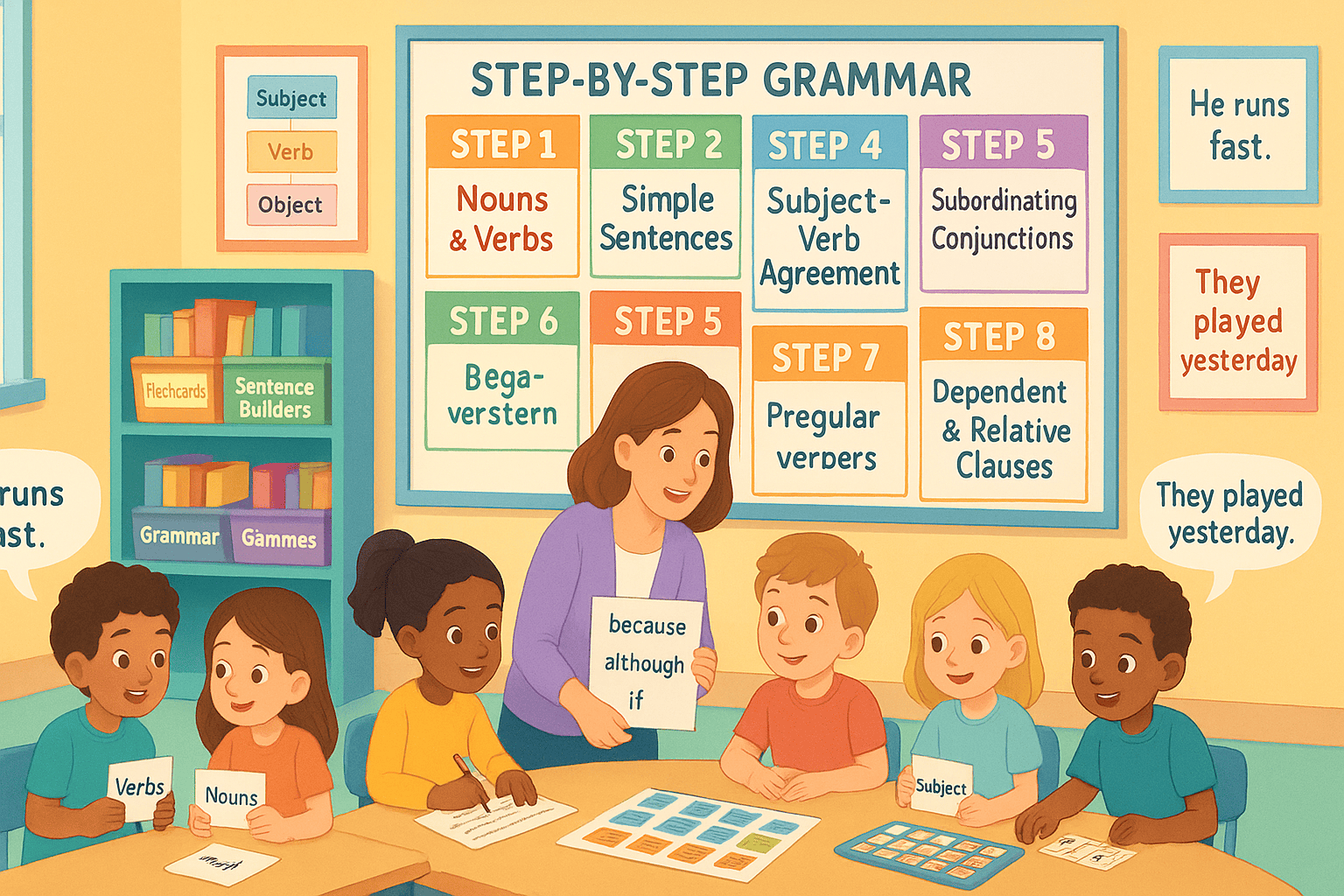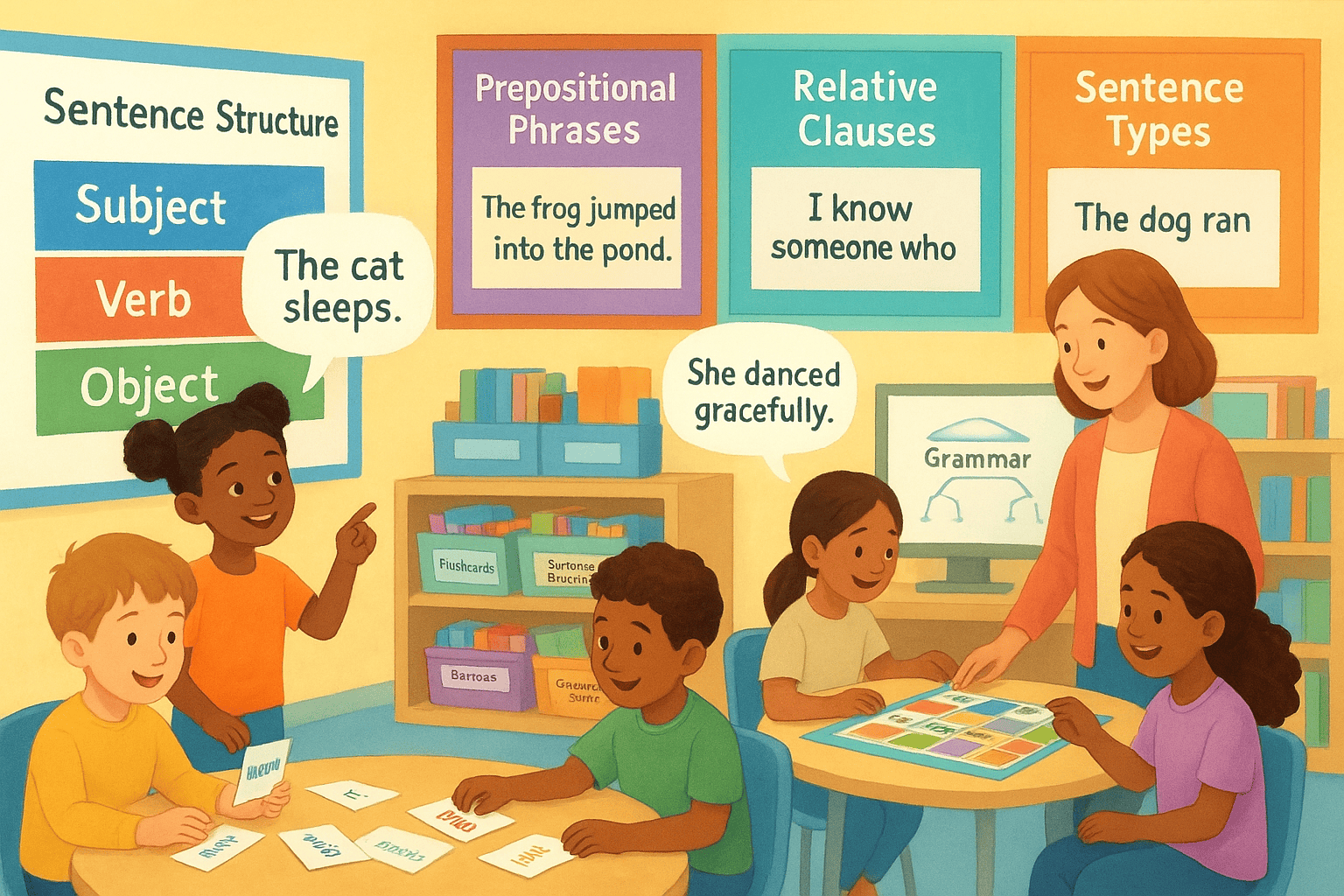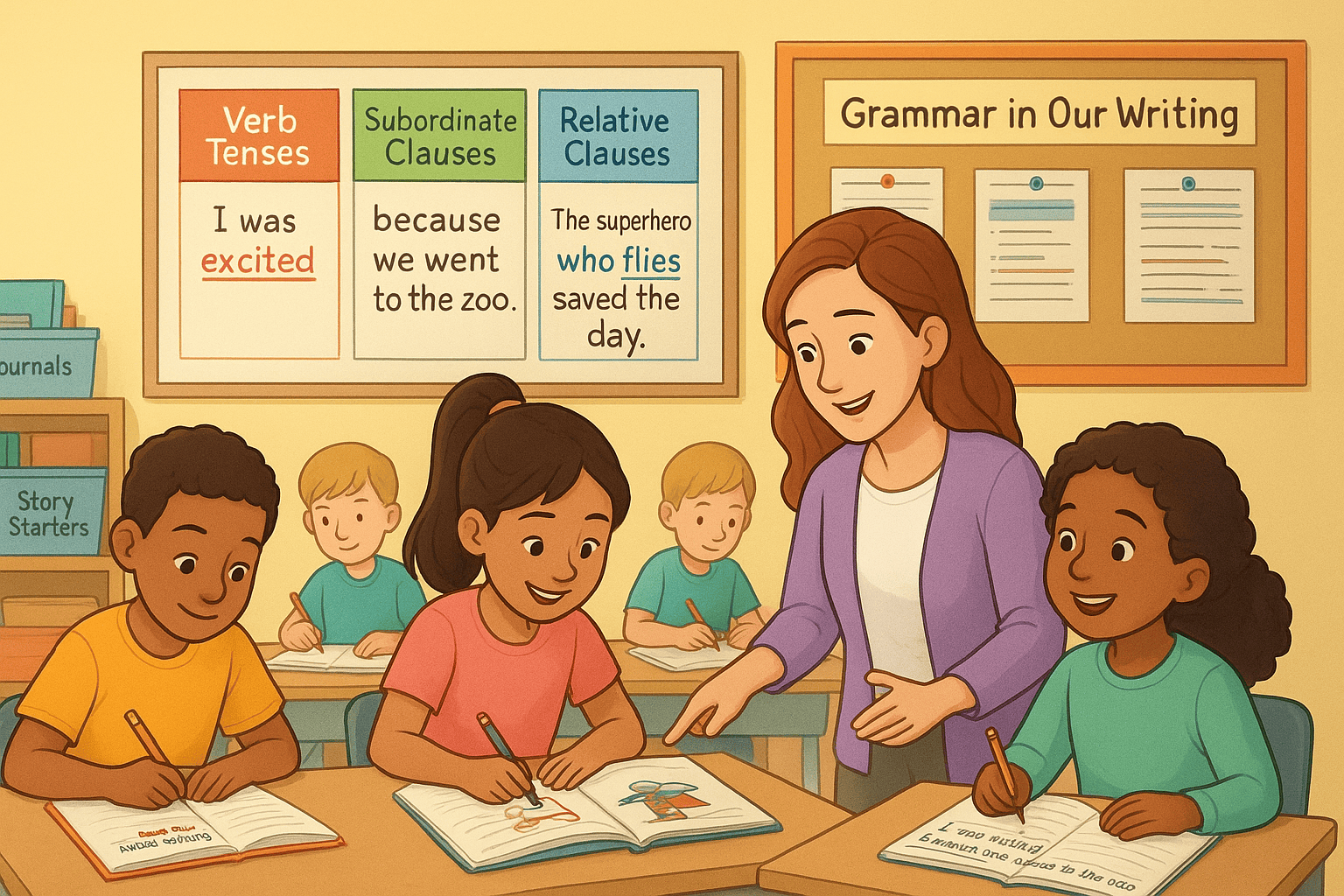Top 12 Effective Strategies for Teaching English Grammar to Children
Top 12 Effective Strategies for Teaching English Grammar to Children
Innovative methods of teaching English grammar to children don’t have to be boring or repetitive. When grammar instructor uses interactive, creative, and age-appropriate activities, young learners gain grammar skills faster and remember grammatical concepts longer. This article shares 12 proven strategies for teaching grammar to kids. It combines play, structured practice, and engaging lessons.
Teach Children Grammar Effectively with Proven Methods: Best Practices for Young Learners
Kids grasp grammar most effectively when teachings are relevant, visual, and steady. Teachers and parents should focus on one grammar rule at a time. They should reinforce it often and provide hands-on practice opportunities. Good grammar instruction starts with real-life examples rather than abstract rules. Use everyday situations to show simple sentences and proper grammar in action. For example, point out subject-verb agreement when reading a story.
Use games and movement to keep engagement high. Use visual aids like color-coding, charts, or sentence builders. They help students grasp parts of speech and sentence structures better. Encourage regular revision with storytelling or group activities.
This helps English language learners gain a better understanding of the english language and remember grammar concepts. This base gives children a solid foundation in English grammar, grammatical structures, and basic sentence structure before introducing complexity.

Introduce Grammar in Small, Manageable Steps
Grammar instruction feels overwhelming if too many grammatical concepts come at once. Break lessons into smaller units using an inductive approach and sometimes a deductive approach to clarify concepts . Start with nouns, verbs, and simple sentences. Then, move to present tense versus past tense or complex sentences.
Teach children grammar by focusing on specific grammar rules one by one. For example, begin with subject-verb agreement and basic present tense verbs. Then move to past tense verbs, subordinating conjunctions, and regular vs irregular forms. Use short daily grammar drills and allow students to practice grammar in manageable portions.
Increase difficulty step by step. First, ensure students know basic grammar. Then, add prepositional phrases, dependent clauses, relative clauses, and subordinate clauses. This step-by-step grammar guide helps kids gain confidence. It also cuts down on anxiety and strengthens their understanding.

Incorporate Visual Aids and Charts
Young learners often respond strongly to visual tools. Using grammar charts, posters, flashcards, fun games diagrams, digital tools helps children understand parts of speech, and students share their insights on sentence structures and key grammar rules. For example, display color-coded posters for subjects, verbs, objects to highlight sentence structure.
Use a grammar wall with labels for prepositional phrases and relative clauses so children refer to them during writing. A mentor text showing a range of sentence combining and complex sentences gives students concrete grammar instruction. Visual aids help students understand grammar better, especially when they create their own examples to illustrate concepts. They show correct grammar in context. They also support English language learners by highlighting grammatical patterns.

Encourage Journaling or Creative Writing
Writing helps students apply grammar rules naturally. When children write their own writing stories or journals, they practice grammar in context rather than isolated drills.
Write about a day that made you happy
Design a superhero with special abilities
This helps students practice verb tenses, subordinate clauses, and relative clauses.After writing, highlight correct grammar in student work. This helps reinforce grammar concepts. Peer sharing or mentor texts can model proper grammar. Journaling deepens grammar understanding. It also boosts reading comprehension. Plus, it shows students how grammar works in real language.

Adapt Grammar Lessons to Each Child's Learning Style
Every child learns grammar differently, and understanding this is an essential aspect of effective teaching. Some grasp grammar through reading or seeing, others respond to hearing or doing. Use songs, chants, and videos (incorporate songs) for auditory learners so they hear parts of speech, past tense verbs, present tense rules in rhythm.
Use role-playing or hands-on activities for kinesthetic learners to act out simple sentences or build sentences with blocks. Reflective learners gain from writing exercises and grammar books.
They can study mentor sentences and analyze grammar rules. Effective teaching helps kids grasp proper usage and complex rules in grammar. Personalized learning boosts motivation. When kids succeed, they want to try harder grammar.
Pair Grammar with Art or Craft Projects
Combining grammar rules with art or craft helps students connect visual, creative, and tactile learning. Make "parts of speech monsters". Use different colors, shapes, or crafted parts. Each one shows nouns, verbs, or adjectives.
Design grammar scavenger hunts:
Hide sticky notes with simple sentences
Place notes with verb tenses
Include notes with prepositional phrases around the classroom
Encourage students to make “verb-action” posters. They should show present tense and past tense verbs with drawings of movement. These engaging lessons make grammar fun and memorable. Children remember grammar concepts in the target language better when they can touch, see, and create things that show how grammar works.
Incorporate Songs, Games, and Movement
Active, fun activities help English language learners internalize grammar.
Use songs that show past tense and present tense
Try chants that focus on simple sentences
Include relative clauses and prepositional phrases
Play grammar games like verb conjugation relay races
Try sentence combining games
Enjoy grammar bingo that focuses on parts of speech
Movement: Demonstrate verb tenses (jump for present, step back for past), role-playing dialogues using correct grammar. These activities keep students engaged and encourage them to create stories, making English grammar instruction lively and memorable.
Address Common Mistakes and Misunderstandings
Even with careful grammar lessons, children often slip.
Teachers should look for mistakes in:
Subject-verb agreement
Misuse of past tense verbs
Wrong prepositional phrases
Confusing relative or subordinate clauses
Use error correction gently: provide students with common mistakes via mentor sentences. Let students identify and correct errors themselves, that helps them internalize grammatical rules.
For example: Share a sentence like “He go to school every day” and ask students to find the mistake. Correct grammar instruction means finding errors as they occur and validating correct patterns.
Use Mentor Texts and Sentence Combining
Mentor texts, like those from published authors, show good grammar. They use complex and varied sentence structures. These examples help improve writing skills in the language . Teachers can analyze mentor sentences with students. They can explore how authors use prepositional phrases, dependent clauses, and relative clauses. Then students try sentence combining: merge simple sentences into complex sentences.
For example: “The dog barked. The dog chased the cat.” → “The dog barked and chased the cat.” This practice strengthens grammar concepts and gives students confidence with complex sentence structures.
Offer Personalized Feedback and Encourage Students to Share
Personalized learning matters. Give individual feedback on students’ writing and speaking. Highlight when they use correct grammar in the target language and point out strong parts in their own writing. For example, say, “You used dependent clauses well here.
Encourage students to share their own examples in class. Let peers discuss grammar concepts together, share successes and struggles. When students take charge of their practice and share it, they understand grammar better. This also boosts their confidence in speaking and writing in English.
Review and Reinforcement Over Time
Grammar instruction does not end when a lesson ends. Reinforce grammar skills over time, especially for students who speak other languages. Use revision games, quizzes, stories revisited, and group storytelling to revisit grammar concepts. Periodically review past tense vs present tense, subordinate clauses, and other grammar rules already taught. This reinforcement helps students retain grammar rules in long-term memory. It prevents forgetting and strengthens English grammar skills.
English Grammar Lessons - FAQs
What are some engaging strategies for teaching grammar to children effectively?
Use interactive storytelling, games, and hands-on activities. This helps young learners link grammar concepts to real language use. Break grammar rules into small steps. Start with parts of speech and basic sentence structure. Then, model present tense and past tense using mentor sentences. Incorporate sentence combining and group storytelling to practice complex sentences and dependent clauses. These engaging lessons build grammar skills, encourage students, and make learning grammar stick.
What are some best practices for teaching grammar in an engaging manner?
Begin with a simple approach. Focus on one grammar concept at a time. Use visual aids and color-coded charts. Show subject-verb agreement and prepositional phrases clearly. Mix direct teaching with hands-on discovery.
First, show examples. Then, allow students find patterns in grammar. Use daily drills, mentor texts, and reading exercises to strengthen key grammar rules. Make lessons active and connect them to everyday situations. This helps students understand and use grammar naturally.
What strategies work best for teaching grammar to children who are learning English as a second language?
For ESL students, use visual aids along with repetition. This helps them hear verb tenses and correct grammar in context. Also, provide plenty of oral practice. Use role-play, songs, and simple stories to model present tense, past tense verbs, and common grammar concepts.
Use prompts to help you start writing
Try sentence frames to guide your thoughts
These tools will boost your confidence in grammar
They make writing easier and more fun
Fill in the blanks to practice different structures
Combine prompts and frames for better results
Real-life examples and regular feedback help English language learners apply rules in speaking and writing.
How can parents reinforce grammar lessons at home?
Parents can read mentor texts aloud. They can also point out parts of speech in familiar stories. Fun games like Mad Libs help practice parts of speech and verb conjugations. Encourage kids to journal or do short writing tasks. This helps them use grammar rules in their writing.
Also, gently correct their common mistakes when you talk with them. Use digital tools or grammar books for more practice on subject-verb agreement and prepositional phrases. Regular, low-pressure practice builds a solid foundation in English grammar.
What is the best way to approach teaching grammar to children with different learning needs?
Differentiate instruction by using visual aids, songs, and hands-on activities. This way, visual, auditory, and kinesthetic learners can all grasp grammatical concepts. Create personalized learning paths. Use direct instruction for complex rules.
Use inductive tasks for discovery and deeper understanding. Use mentor sentences and scaffolding for older students. For beginners, use simple sentences. Frequent formative checks help you see if students understand. They also let you adjust lessons for each student’s progress.
How does collaborative learning improve grammar skills in children?
Group projects and peer editing help students see grammatical concepts. They can spot things like relative clauses and subordinate clauses in real writing. When students share examples and help fix each other’s simple sentences, they practice grammar.
This also helps them remember important grammar rules. Collaborative tasks like sentence combining, group storytelling, and grammar games help students talk about grammar rules. This talking deepens their understanding. Working together also builds confidence and motivation to apply grammar in their own writing.
What techniques can make grammar learning more interactive and hands-on for children?
Try sentence-building puzzles, grammar scavenger hunts, and role-play. These activities help students use correct grammar right away. Make art projects like "parts of speech monsters" to visualize nouns, verbs, and adjectives. Also, create verb-action posters that display present and past tense. Incorporate songs and movement to teach verb tenses and subject-verb agreement so learning sticks. Hands-on activities turn abstract grammar rules into memorable experiences.
How important is consistency in reinforcing grammar rules to children?
Consistency is key. Short daily warm-ups, quick revision games, and spaced practice help students remember grammar rules. This approach also reduces common mistakes. Review grammar topics such as verb conjugations, prepositional phrases, and dependent clauses over several weeks, not all at once. Frequent, short practice helps with reading comprehension. It also allows students to use grammar in their speaking and writing. Regular feedback ensures students understand and steadily improve.